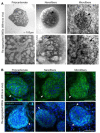Salivary Gland Bioengineering
- PMID: 38247905
- PMCID: PMC10813147
- DOI: 10.3390/bioengineering11010028
Salivary Gland Bioengineering
Abstract
Salivary gland dysfunction affects millions globally, and tissue engineering may provide a promising therapeutic avenue. This review delves into the current state of salivary gland tissue engineering research, starting with a study of normal salivary gland development and function. It discusses the impact of fibrosis and cellular senescence on salivary gland pathologies. A diverse range of cells suitable for tissue engineering including cell lines, primary salivary gland cells, and stem cells are examined. Moreover, the paper explores various supportive biomaterials and scaffold fabrication methodologies that enhance salivary gland cell survival, differentiation, and engraftment. Innovative engineering strategies for the improvement of vascularization, innervation, and engraftment of engineered salivary gland tissue, including bioprinting, microfluidic hydrogels, mesh electronics, and nanoparticles, are also evaluated. This review underscores the promising potential of this research field for the treatment of salivary gland dysfunction and suggests directions for future exploration.
Keywords: organoid; regeneration; salivary gland; tissue engineering.
Conflict of interest statement
The authors declare no conflicts of interest.
Figures









References
-
- Sasportas M., Hosford A., Sodini M., Waters J., Zambricki A., Barral J., Graves E., Brinton T., Yock P., Quyhh-Thu L., et al. Cost-Effectiveness Landscape Analysis of Treatments Addressing Xerostomia in Patients Receiving Head and Neck Radiation Therapy. Oral Surg. Oral Med. Oral Pathol. Oral Raiol. 2013;116:e37–e51. doi: 10.1016/j.oooo.2013.02.017. - DOI - PMC - PubMed
-
- Jensen S.B., Pedersen A.M.L., Vissink A., Andersen E., Brown C.G., Davies A.N., Dutilh J., Fulton J.S., Jankovic L., Lopes N.N.F., et al. A Systematic Review of Salivary Gland Hypofunction and Xerostomia Induced by Cancer Therapies: Prevalence, Severity and Impact on Quality of Life. Support. Care Cancer. 2010;18:1039–1060. doi: 10.1007/s00520-010-0827-8. - DOI - PubMed
-
- Stewart B.W., Wild C.P. World Cancer Report 2014. World Health Organization; Geneva, Switzerland: 2014.
-
- Polaris Market Research Xerostomia Therapeutics Market Share, Size, Trends, Industry Analysis Report, By Type (OTC, Prescription), By Product, By Region, And Segment Forecasts, 2023–2032, Report Summary. [(accessed on 25 August 2023)]. Available online: https://www.polarismarketresearch.com/industry-analysis/xerostomia-thera....
Publication types
Grants and funding
LinkOut - more resources
Full Text Sources

